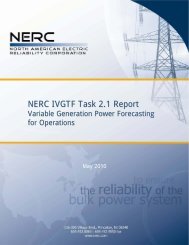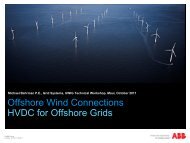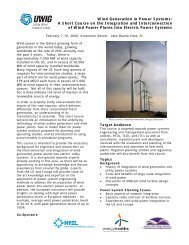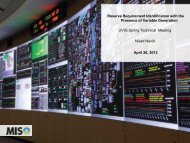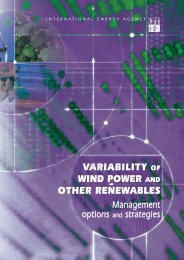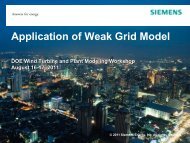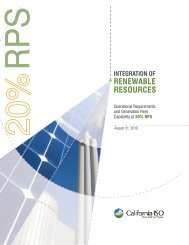Integrating Southwest Power Pool Wind to Southeast Electricity ...
Integrating Southwest Power Pool Wind to Southeast Electricity ...
Integrating Southwest Power Pool Wind to Southeast Electricity ...
Create successful ePaper yourself
Turn your PDF publications into a flip-book with our unique Google optimized e-Paper software.
Unit Startups<br />
Changing the balancing strategy can change the number of starts for units. The cost of cycling<br />
and ramping on conventional generation in terms of effect on forced outage rate, maintenance<br />
costs and heat rate degradation is not studied here (and is in fact not well unders<strong>to</strong>od in general at<br />
present). As such, the effect of wind on cycling can only be seen from the UPLAN production<br />
cost model results in how it changes the number of start/s<strong>to</strong>p operations of units. More cycling<br />
operation would likely result in more breakdowns, maintenance scheduling and possibly early<br />
retirement, therefore strategies that reduce this will be beneficial, in particular for coal or older<br />
CC units.<br />
Figure 5-22 shows the average number of starts per year by unit type for each region. Note that<br />
these starts are not necessarily attributable <strong>to</strong> wind variability as normal load cycling and forced<br />
or unforced outages also drive some portion of the starts. Increased levels of wind, however,<br />
will increase the cycling of the units. Given that the data in Figure 5-22 compares scenarios all<br />
with 48 GW of wind, the differences between scenarios indicates how balancing cooperation<br />
strategies impact cycling. Only CC and coal are shown as these are the units not specifically<br />
designed <strong>to</strong> start and ramp as frequently as GTs would be. In addition, coal in Entergy is not<br />
shown as starts do not change. As expected, coal units, which have larger start costs and times<br />
and longer minimum up times, do not cycle on and off significantly.<br />
Figure 5-22<br />
Average number of starts by unit type<br />
Table 5-13 shows the average number of starts per unit of each type per year for Scenario #1 and<br />
the change in the number of starts for each of the other scenarios relative <strong>to</strong> Scenario 1 with a<br />
positive value indicating an increase in starts versus scenario 1. In addition <strong>to</strong> the high wind<br />
transfer case scenarios, the low wind case of 14 GW with unconstrained transmission is shown<br />
for comparison of how the additional 34 GW of wind impacts unit starts. The additional 34 GW<br />
of wind generally results in more starts in the SERC regions as more cheap and variable energy<br />
is available, but the numbers are not as dramatic as might be expected. CC units in Entergy and<br />
TVA cycle off on average 25 and 16 times more per unit per year in the high wind case,<br />
5-29




